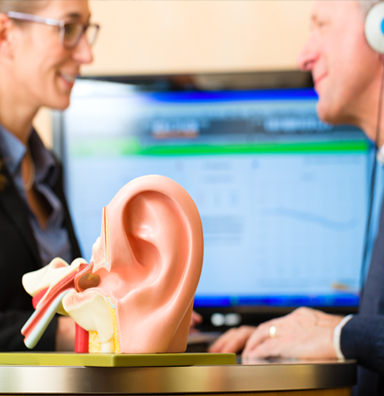Hearing Tests
Hearing tests can determine the type and degree of your hearing loss. This is vital information your audiologist will need to create your individualized treatment plan.
Pure-Tone Testing
This type of test can determine the faintest tones you can hear at a variety of pitches. You will be asked to sit in a specially designed sound booth and wear a pair of headphones. This test enables your audiologist to check for unilateral hearing loss, which is hearing loss in just one ear.
A series of tones will be played through the headphones. Every time you hear a tone you are instructed to raise your hand or press a button. At the end of the test your results are recorded on an audiogram. This is a visual representation of how well you can hear.
The standard version of this test can be performed on children as young as five years of age. Any younger and the test must be modified to fit the child’s capability. Children two to five years of age can be tested with conditioned play audiometry. The child is trained to perform a task every time they hear a tone, such as putting a block in a box or placing a ring on a cone.
Speech Testing
This test is able to measure your ability to understand speech. It can determine your speech reception threshold (SRT) and your word recognition ability (WRS) these results are reported on your audiogram. The audiologist will read a list of words aloud and you will be to recite the list of words back to the audiologist.
Middle Ear Testing
This category of auditory tests is used to determine how well the middle ear is working. This is especially important when testing children, as they are prone to middle ear infections. A tympanometry is an exam used to determine if there is a blockage of earwax, fluid buildup within the middle ear or a perforated eardrum. Air is gently introduced into the ear and the amount the eardrum moves is measured and recorded on a graph called a tympanogram.
Acoustic reflex measures provide another level of information to the audiologist about the location of the hearing problem. Typically, when a loud sound is heard, a muscle in the middle ear contracts. This is called an acoustic reflex. To measure the loudness level at which an acoustic reflex occurs, a probe is placed in the ear and a range of tones is played.
Auditory Brainstem Response
This test provides the audiologist with information about how well the inner ear, specifically the cochlea and auditory pathway, is working. Electrodes are placed on the head to record brain activity. Then, a series of tones is played and the brain’s response is measured. For more information, Contact Us Today at Provo, UT Center.
